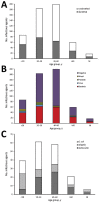Enteric Infections Circulating during Hajj Seasons, 2011-2013
- PMID: 28930004
- PMCID: PMC5621540
- DOI: 10.3201/eid2310.161642
Enteric Infections Circulating during Hajj Seasons, 2011-2013
Abstract
Hajj, the annual Muslim pilgrimage to Mecca, Saudi Arabia, is a unique mass gathering event that raises public health concerns in the host country and globally. Although gastroenteritis and diarrhea are common among Hajj pilgrims, the microbial etiologies of these infections are unknown. We collected 544 fecal samples from pilgrims with medically attended diarrheal illness from 40 countries during the 2011-2013 Hajj seasons and screened the samples for 16 pathogens commonly associated with diarrheal infections. Bacteria were the main agents detected, in 82.9% of the 228 positive samples, followed by viral (6.1%) and parasitic (5.3%) agents. Salmonella spp., Shigella/enteroinvasive Escherichia coli, and enterotoxigenic E. coli were the main pathogens associated with severe symptoms. We identified genes associated with resistance to third-generation cephalosporins ≈40% of Salmonella- and E. coli-positive samples. Hajj-associated foodborne infections pose a major public health risk through the emergence and transmission of antimicrobial drug-resistant bacteria.
Keywords: Hajj; Saudi Arabia; antimicrobial resistance; bacteria; diarrhea; enteric infections; mass gathering; viruses.
Figures

Similar articles
-
An investigation of traveller's diarrhoea.Lancet. 1970 Jan 3;1(7636):1-5. doi: 10.1016/s0140-6736(70)90520-9. Lancet. 1970. PMID: 4188342 No abstract available.
-
Diarrhegenic Escherichia coli Replaces Shigella spp. as the Predominant Bacteria Causing Childhood Diarrhea in Andaman and Nicobar Islands, India.Am J Trop Med Hyg. 2018 Mar;98(3):814-815. doi: 10.4269/ajtmh.17-0327. Epub 2018 Jan 18. Am J Trop Med Hyg. 2018. PMID: 29363445 Free PMC article. No abstract available.
-
Acquisition of enteric pathogens by pilgrims during the 2016 Hajj pilgrimage: A prospective cohort study.Travel Med Infect Dis. 2018 Sep-Oct;25:26-30. doi: 10.1016/j.tmaid.2018.05.017. Epub 2018 May 31. Travel Med Infect Dis. 2018. PMID: 29859239
-
Childhood bacterial diarrhoea in a regional hospital in Saudi Arabia: clinico-aetiological features.J Trop Med Hyg. 1994 Apr;97(2):87-90. J Trop Med Hyg. 1994. PMID: 8170008 Review.
-
Epidemiologic aspects of shigellosis and other causes of dysentery in Thailand.Rev Infect Dis. 1991 Mar-Apr;13 Suppl 4:S226-30. doi: 10.1093/clinids/13.supplement_4.s226. Rev Infect Dis. 1991. PMID: 2047642 Review.
Cited by
-
Genomic characterization of NDM-1 and 5, and OXA-181 carbapenemases in uropathogenic Escherichia coli isolates from Riyadh, Saudi Arabia.PLoS One. 2018 Aug 15;13(8):e0201613. doi: 10.1371/journal.pone.0201613. eCollection 2018. PLoS One. 2018. PMID: 30110357 Free PMC article.
-
Evaluation of trauma cases in different types of mass gathering events.Ulus Travma Acil Cerrahi Derg. 2022 Jun;28(6):781-789. doi: 10.14744/tjtes.2021.17971. Ulus Travma Acil Cerrahi Derg. 2022. PMID: 35652867 Free PMC article.
-
Diversity and antimicrobial susceptibility patterns of clinical and environmental Salmonella enterica serovars in Western Saudi Arabia.Folia Microbiol (Praha). 2024 Dec;69(6):1305-1317. doi: 10.1007/s12223-024-01172-1. Epub 2024 May 20. Folia Microbiol (Praha). 2024. PMID: 38767834
-
Evaluation of the rate, pattern and appropriateness of antibiotic prescription in a cohort of pilgrims suffering from upper respiratory tract infection during the 2018 Hajj season.Access Microbiol. 2022 Apr 25;4(4):000338. doi: 10.1099/acmi.0.000338. eCollection 2022. Access Microbiol. 2022. PMID: 35812707 Free PMC article.
-
Gastrointestinal symptoms and knowledge and practice of pilgrims regarding food and water safety during the 2019 Hajj mass gathering.BMC Public Health. 2021 Jul 1;21(1):1288. doi: 10.1186/s12889-021-11381-9. BMC Public Health. 2021. PMID: 34210302 Free PMC article.
References
-
- GBD 2013 Mortality and Causes of Death Collaborators. Global, regional, and national age-sex specific all-cause and cause-specific mortality for 240 causes of death, 1990-2013: a systematic analysis for the Global Burden of Disease Study 2013. Lancet. 2015;385:117–71. 10.1016/S0140-6736(14)61682-2 - DOI - PMC - PubMed
MeSH terms
LinkOut - more resources
Full Text Sources
Other Literature Sources
Medical
Miscellaneous

